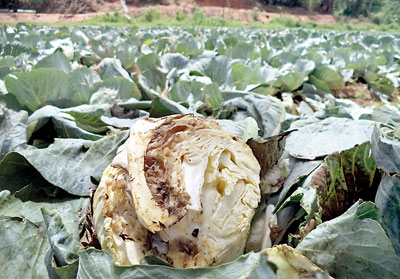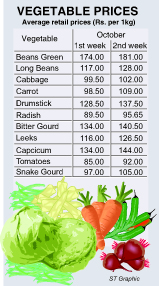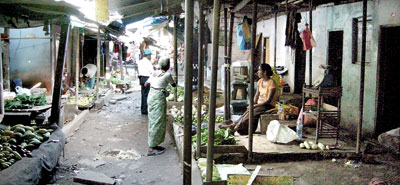News
Drought or deluge: Farmers must learn to adapt
Leading climatologists say Sri Lanka’s farmers must adapt to increasing intensity of weather patterns, whether heavy rains or severe drought, both of which are now simultaneously hitting the agricultural sector.
The current combination of drought and heavy rain is producing tons of unsaleable rotting vegetables in some parts of the country while in drought-hit areas paddy farmers face the bleak prospect of the year’s main crop, Maha, without enough water.
Prices of vegetables are shooting up at the markets. Vendors at the Dambulla economic centre say prices have risen by 60 per cent.

Rotting cabbage
“Vegetables that come to the economic centre are of poor quality and cannot be kept for a few days,” a vendor said. Vast vegetable farms in the Matale district were destroyed in last week’s torrential rains.
Dr. Ranjith Punyawardena, the Agriculture Department’s Chief Climatologist, said the intensity of current weather has increased, whether severe drought or rainfall.
“Although October and November traditionally brings the highest rainfall, this time the intensity is high,” he said.
He said vegetable farmers should improve their drainage systems to reduce the impact of this weather change and that paddy farmers should start land preparation with the rain they are getting and not wait for water levels in reservoirs to increase.
“With the increase in drinking water consumption both in the industrial and service sector, the Irrigation Department’s priority is now to fulfil that need.
“Therefore farmers should make maximum usage of falling rains as overall insufficient rainfall will mean water supply to the agricultural sector will be cut down,” he said.

Nalaka Indunil, a vegetable vendor at the Maradana market
The Meteorology Department’s Director of Forecasts, S.R. Jayasekera, said 30 per cent of the country’s rainfall has come in the past two months and that atmospheric disturbances would lead to more intense rain, wind and  thunderstorms in coming weeks.
thunderstorms in coming weeks.
Samanalawewa in Balangoda received more than 200mm of rain this week and Katugastota, Samanalawewa, Tissamaharama were among areas that received more than 100mm.
Conversely, Anuradhapura only received 13.8mm, Batticaloa 4.6mm, Jaffna 6mm, Polonnaruwa 7.9mm and Moneragala 10.1mm by Friday.
The Meteorology Department said several days of 100mm rains should be received for the drought to end.
“The country will need heavy showers during October and November in order to end the drought, fill the reservoirs and catchments,” said Mr. Jayasekera.
Reservoirs and tanks in drought-stricken areas are yet to receive rains to commence the major paddy season, Maha.The severe conditions which brought down water levels in reservoirs to a mere 12 per cent has eased slightly but not enough.
“The present level is only 20 per cent. This is not at all sufficient to start the Maha season. There should be at least 35 per cent for the commencement of cultivation,” said the Irrigation Department’s Director of Water Management, Janaki Meegastenna.
Only three small reservoirs, Ambewela in Badulla, Bathalagoda in Kurunegala and Van-ela in Trincomalee, had reached spill level.
“Senanayake Samudraya in Ampara, which heavily contributes to the country’s paddy cultivation, is only 8 per cent full,” Ms Meegastenna said.

Manning Market: Vendors complain of poor quality vegetables. Pix by Athula Devapriya
Vegetable farmers, both up-country and low-country, have been badly hit by heavy rain.
According to Hector Kobbekaduwa Agrarian Research and Training Institute (HARTI), this year’s Yala season was low in districts such as Matale and Kandy due to scarce rainfall.
Hopes of better crop with the rains were shattered for some vegetable farmers with deluges spoiling some major crops.
Onion growers who had their crop rejected held a protest outside the Dambulla economic centre, demanding that authorities buy large onions at Rs. 80 per kilo instead of the current Rs. 55 per kilo, with the retail price being Rs. 86.
Almost all vegetable prices have increased except for pumpkin. According to the Census and Statistics Department, the average retail price of a kilo of green beans has risen from Rs.174 to Rs.181 in a week.
Vendors at the major Colombo markets complain that they are getting low-quality vegetables and complaints from the public over the increasing prices.
“We are waiting for vegetables to come – the city depends on the vegetables coming to the Manning Market. But all we get is boxes full of tomatoes,” complained a vendor in the Manning Market in Pettah.
Nalaka Indunil, a vegetable vendor at the Maradana market said supermarket chains had grabbed most of the vegetable supply, forcing small-scale vendors out of work.
Consumers are struggling to feed their families with the current prices.
“A few weeks ago, vegetable prices dropped. But now the prices especially carrots, beans, leeks have gone up. The quality of vegetables is also bad,” said one woman, K. Sriyani, who was shopping for vegetables for a family of six.
(Additional reporting by Kanchana Kumara
Ariyadasa)

